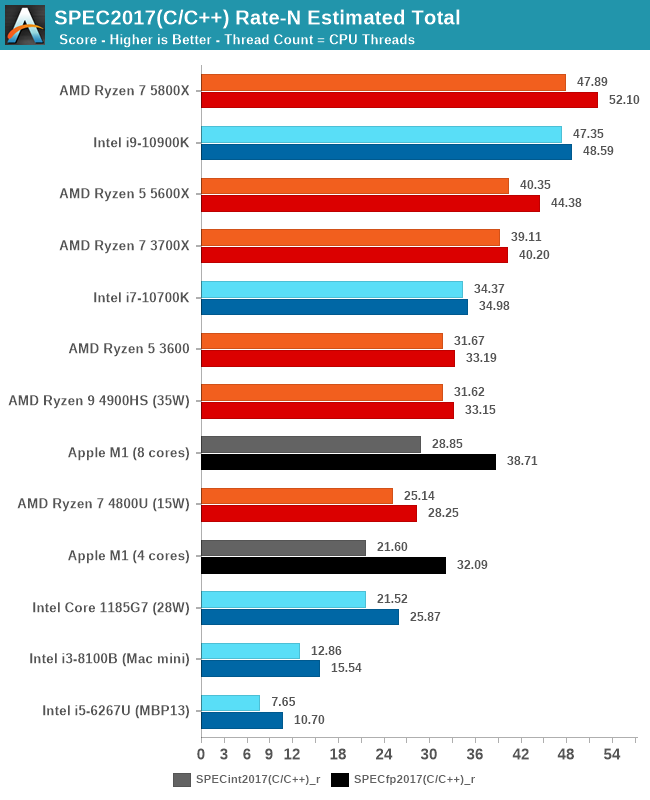The 2020 Mac Mini Unleashed: Putting Apple Silicon M1 To The Test
by Andrei Frumusanu on November 17, 2020 9:00 AM ESTSPEC2017 - Multi-Core Performance
While we knew that the Apple M1 would do extremely well in single-threaded performance, the design’s strengths are also in its power-efficiency which should directly translate to exceptionally good multi-threaded performance in power limited designs. We noted that although Apple doesn’t really publish any TDP figure, we estimate that the M1 here in the Mac mini behaves like a 20-24W TDP chip.
We’re including Intel’s newest Tiger Lake system with an i7-1185G7 at 28W, an AMD Ryzen 7 4800U at 15W, and a Ryzen 9 4900HS at 35W as comparison points. It’s to be noted that the actual power consumption of these devices should exceed that of their advertised TDPs, as it doesn’t account for DRAM or VRMs.

In SPECint2017 rate, the Apple M1 battles with AMD’s chipsets, with the results differing depending on the workload, sometimes winning, sometimes losing.

In the fp2017 rate results, we see similar results, with the Apple M1 battling it out with AMD’s higher-end laptop chip, able to beat the lower TDP part and clearly stay ahead of Intel’s design.

In the overall multi-core scores, the Apple M1 is extremely impressive. On integer workloads, it still seems that AMD’s more recent Renoir-based designs beat the M1 in performance, but only in the integer workloads and at a notably higher TDP and power consumption.
Apple’s lead against Intel’s Tiger Lake SoC at 28W here is indisputable, and shows the reason as to why Apple chose to abandon their long-term silicon partner of 15 years. The M1 not only beats the best Intel has to offer in this market-segment, but does so at less power.
I also included multi-threaded scores of the M1 when ignoring the 4 efficiency cores of the system. Here although it’s an “8-core” design, the heterogeneous nature of the CPUs means that performance is lop-sided towards the big cores. That doesn’t mean that the efficiency cores are absolutely weak: Using them still increases total throughput by 20-33%, depending on the workload, favouring compute-heavy tasks.
Overall, Apple doesn’t just deliver a viable silicon alternative to AMD and Intel, but actually something that’s well outperforms them both in absolute performance as well as power efficiency. Naturally, in higher power-level, higher-core count systems, the M1 can’t keep up to AMD and Intel designs, but that’s something Apple likely will want to address with subsequent designs in that category over the next 2 years.










682 Comments
View All Comments
RedGreenBlue - Tuesday, November 17, 2020 - link
Obviously their new designs are way off the beaten path in their improvements than the canned designs by now.dotjaz - Wednesday, November 18, 2020 - link
You must be smoking something really good. A7 was a 6-wide design while CA57 was only 3-wide. Cyclone also has 4/2/2/3 (Int/Branch/LS/NEON) units while A57 only had (2+1)/1/2/2. That's completerly different design.RedGreenBlue - Wednesday, November 18, 2020 - link
I was thinking of the A6 that was the first modification of ARM’s architecture and before that they were fundamentally copies. It’s not easy to remember which article of Anand Shimpi’s commentary I read 7 or 8 years ago. https://www.anandtech.com/show/6330/the-iphone-5-r...danbob999 - Thursday, November 19, 2020 - link
They are dumb if they pay for designs which they do not use. The instruction set must be cheaper, otherwise ARM got it the wrong way.It's like saying that the cost of food at a groceries store is higher than the complete meal at the restaurant.
michael2k - Thursday, November 19, 2020 - link
It's actually more accurate to say, "Paying for the time of the restaurant's menu designer costs more than either the groceries or the meal"With an architectural license, they get access to to a specification, which is closer to a menu, recipes, and a shopping list, than a meal or groceries.
dotjaz - Wednesday, November 18, 2020 - link
No helios24 is INCORRECT. It's the top of the licensing for sure, but it also doesn't include any hard IP. It's the broadest in use case as you can do ANYTHING with it as long as you are ISA compliant. But it's also the narrowest in terms of ARM IP portfolio. For example Huwwei still hold ARM architectural license and can design their own ARM cores, but they don't have access to anything newer than CA77 because that's a different license.Architectual license is also the cheapest *once you have certain volume*. The initial licensing fee is high, BUT you don't pay much royalty on a per-core basis becase you don't use ARM IP other than ISA.
dotjaz - Wednesday, November 18, 2020 - link
Maybe this will help you understand more. The top of the pyrimid actually don't have access to ARM's standard IP portfolio at all.https://semiaccurate.com/2013/08/07/a-long-look-at...
michael2k - Thursday, November 19, 2020 - link
The article here contradicts you: https://semiaccurate.com/2013/08/07/a-long-look-at...On top of the pyramid is both the highest cost and lowest licensee count option, but those two factors are probably not directly related. The reason is this one is called an architectural license and you don’t actually get a core, you get a set of specs for a core and a compatibility test suite.
mjkpolo - Thursday, November 19, 2020 - link
Actaully nVidia purchased ARM lolHenry 3 Dogg - Friday, November 27, 2020 - link
"ARM was founded as a joint venture between Apple and Acorn."No. ARM was founded by Acorn spinning out its inhouse developed ARM chip as a separate company. Apple bought in later as an investment, and to prevent take overs that might threaten its Newton product.